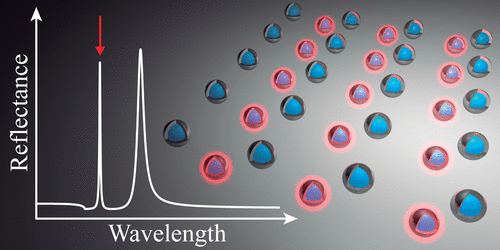Our official English website, www.x-mol.net, welcomes your
feedback! (Note: you will need to create a separate account there.)
Hybridization of Lattice Resonances
ACS Nano ( IF 15.8 ) Pub Date : 2018-01-18 00:00:00 , DOI: 10.1021/acsnano.7b08206 Sebastian Baur 1 , Stephen Sanders 1 , Alejandro Manjavacas 1
ACS Nano ( IF 15.8 ) Pub Date : 2018-01-18 00:00:00 , DOI: 10.1021/acsnano.7b08206 Sebastian Baur 1 , Stephen Sanders 1 , Alejandro Manjavacas 1
Affiliation

|
Plasmon hybridization, the electromagnetic analog of molecular orbital theory, provides a simple and intuitive method to describe the plasmonic response of complex nanostructures from the combination of the responses of their individual constituents. Here, we follow this approach to investigate the optical properties of periodic arrays of plasmonic nanoparticles with multiparticle unit cells. These systems support strong collective lattice resonances, arising from the coherent multiple scattering enabled by the lattice periodicity. Due to the extended nature of these modes, the interaction between them is very different from that among localized surface plasmons supported by individual nanoparticles. This leads to a much richer hybridization scenario, which we exploit here to design periodic arrays with engineered properties. These include arrays with two-particle unit cells, in which the interaction between the individual lattice resonances can be canceled or maximized by controlling the relative position of the particles within the unit cell, as well as arrays whose response can be made either invariant to the polarization of the incident light or strongly dependent on it. Moreover, we explore systems with three- and four-particle unit cells and show that they can be designed to support lattice resonances with complex hybridization patterns in which different groups of particles in the unit cell can be selectively excited. The results of this work serve to advance our understanding of periodic arrays of nanostructures and provide a methodology to design periodic structures with engineered properties for applications in nanophotonics.
中文翻译:

晶格共振的杂交
等离子杂交是分子轨道理论的电磁类似物,它提供了一种简单而直观的方法,可通过组合其各个组成部分的响应来描述复杂纳米结构的等离子体响应。在这里,我们遵循这种方法来研究具有多粒子晶胞的等离激元纳米粒子的周期性阵列的光学性质。这些系统支持强的集体晶格共振,这是由晶格周期性引起的相干多重散射引起的。由于这些模式的扩展性质,它们之间的相互作用与单个纳米粒子支持的局部表面等离子体激元之间的相互作用有很大不同。这导致了更为丰富的杂交方案,我们在这里利用它来设计具有工程特性的周期阵列。这些包括具有两粒子晶胞的阵列,其中通过控制晶胞内粒子的相对位置,可以取消或最大化各个晶格共振之间的相互作用,以及可以使响应对于晶格常数不变的阵列。入射光的偏振或强烈依赖于它。此外,我们探索了具有三粒子和四粒子晶胞的系统,并显示它们可以设计为支持具有复杂杂交模式的晶格共振,在该杂交模式中,可以选择性激发晶胞中不同组的粒子。这项工作的结果有助于增进我们对纳米结构的周期性阵列的理解,并提供一种设计具有工程特性的周期性结构的方法,以用于纳米光子学。通过控制单位晶格内颗粒的相对位置,可以消除或最大化各个晶格共振之间的相互作用,以及可以使响应的变化与入射光的偏振无关或与其密切相关的阵列。此外,我们探索了具有三粒子和四粒子晶胞的系统,并显示它们可以设计为支持具有复杂杂交模式的晶格共振,在该杂交模式中,可以选择性激发晶胞中不同组的粒子。这项工作的结果有助于增进我们对纳米结构的周期性阵列的理解,并提供一种设计具有工程特性的周期性结构的方法,以用于纳米光子学。通过控制单位晶格内颗粒的相对位置,可以消除或最大化各个晶格共振之间的相互作用,以及可以使响应的变化与入射光的偏振无关或与其密切相关的阵列。此外,我们探索了具有三粒子和四粒子晶胞的系统,并表明它们可以设计为支持具有复杂杂交模式的晶格共振,在该杂交模式中,可以选择性激发晶胞中不同组的粒子。这项工作的结果有助于增进我们对纳米结构的周期性阵列的理解,并提供一种设计具有工程特性的周期性结构的方法,以用于纳米光子学。
更新日期:2018-01-18
中文翻译:

晶格共振的杂交
等离子杂交是分子轨道理论的电磁类似物,它提供了一种简单而直观的方法,可通过组合其各个组成部分的响应来描述复杂纳米结构的等离子体响应。在这里,我们遵循这种方法来研究具有多粒子晶胞的等离激元纳米粒子的周期性阵列的光学性质。这些系统支持强的集体晶格共振,这是由晶格周期性引起的相干多重散射引起的。由于这些模式的扩展性质,它们之间的相互作用与单个纳米粒子支持的局部表面等离子体激元之间的相互作用有很大不同。这导致了更为丰富的杂交方案,我们在这里利用它来设计具有工程特性的周期阵列。这些包括具有两粒子晶胞的阵列,其中通过控制晶胞内粒子的相对位置,可以取消或最大化各个晶格共振之间的相互作用,以及可以使响应对于晶格常数不变的阵列。入射光的偏振或强烈依赖于它。此外,我们探索了具有三粒子和四粒子晶胞的系统,并显示它们可以设计为支持具有复杂杂交模式的晶格共振,在该杂交模式中,可以选择性激发晶胞中不同组的粒子。这项工作的结果有助于增进我们对纳米结构的周期性阵列的理解,并提供一种设计具有工程特性的周期性结构的方法,以用于纳米光子学。通过控制单位晶格内颗粒的相对位置,可以消除或最大化各个晶格共振之间的相互作用,以及可以使响应的变化与入射光的偏振无关或与其密切相关的阵列。此外,我们探索了具有三粒子和四粒子晶胞的系统,并显示它们可以设计为支持具有复杂杂交模式的晶格共振,在该杂交模式中,可以选择性激发晶胞中不同组的粒子。这项工作的结果有助于增进我们对纳米结构的周期性阵列的理解,并提供一种设计具有工程特性的周期性结构的方法,以用于纳米光子学。通过控制单位晶格内颗粒的相对位置,可以消除或最大化各个晶格共振之间的相互作用,以及可以使响应的变化与入射光的偏振无关或与其密切相关的阵列。此外,我们探索了具有三粒子和四粒子晶胞的系统,并表明它们可以设计为支持具有复杂杂交模式的晶格共振,在该杂交模式中,可以选择性激发晶胞中不同组的粒子。这项工作的结果有助于增进我们对纳米结构的周期性阵列的理解,并提供一种设计具有工程特性的周期性结构的方法,以用于纳米光子学。











































 京公网安备 11010802027423号
京公网安备 11010802027423号